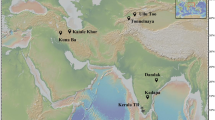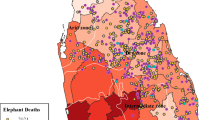Abstract
In May 12, 2008, a strong earthquake occurred in Wenchuan County in the northern Sichuan Province of China. It registered 8.0 on the Richter scale with an 11-degree quake intensity, killing a large number of people, and causing extensive damage to the local environment. Wolong National Nature Reserve is about 30 km away from the epicenter and is one of the most important giant panda (Ailuropoda melanoleuca) habitats in China. Based on the impacts of the Wenchuan 512 earthquake and those of other strong earthquakes in the world, this paper reviews and discusses effects of strong earthquakes on geomorphology, soil chemical and physical properties, forests, bamboo growth, biodiversity, and giant panda habitat. This information may be useful for scientists when undertaking research projects on natural geography, ecological restoration, and habitat restoration in the Reserve and the disaster area.
Similar content being viewed by others
References
Allen R B, Bellingham P J, Wiser S K (1999). Immediate damage by an earthquake to a temperate montane forest. Ecology, 80: 708–714
Briggs S M (2006). Earthquakes. Surg Clin North Am, 86: 537–544
Bussmann RW, Wilcke W, Richter M (2008). Cheaper 24: Landslides as Important Disturbance Regimes. Causes and Regeneration. Gradients in a Tropical Mountain Ecosystem of Ecuador. In: Beck E, Bendix J, Kottke I, eds. Ecological Studies. Heidelberg: Springer-Verlag, 198: 319–331
Chen F B, Mackinnon J R, Lu Z, et al. (2002). Sichuan Giant Panda Sanctuary. Sichuan Press, 122–131
China Ministry of Civil Affairs (CMCA) (2008). Assessment of the disaster areas caused by the Wenchuan 512 earthquake, China (in Chinese)
China Ministry of State Land Resources (CMSLR) (2008). Assessment of the disaster areas caused by the Wenchuan 512 earthquake, China (In Chinese)
Chou W C, Lin W T, Lin C Y (2008). Vegetation recovery patterns assessment at landslides caused by catastrophic earthquake: A case study in central Taiwan. Environm Monit Assess, 245–257
Claesson L, Skelton A, Graham C (2004). Hydrogeochemical changes before and after a major earthquake. Geology, 32: 641–644
Dalling W J, Tanner V J (1995). An experimental study of regeneration on landslides in montane rain forest in Jamaica. J Ecol, 83: 55–64
Fukuzawa K, Shibata H, Takagi K, Satoh F, Koike T, Sasa K (2007). Vertical distribution and seasonal pattern of fine-root dynamics in a cool-temperate forest in northern Japan: implication of the understory vegetation, Sasa dwarf bamboo. Ecol Res, 22: 485–495
Garwood N C, Janos D P, Brokaw N (1979). Earthquake-induced landslides: A major disturbance to tropical soils: Science, 205: 997–999
Geertsma M (2006). Hydrogeomorphic Hazards in Northern British Columbia. Utrecht: The Netherlands, 12–13
Gratani L, Crescente M F, Varone L, Fabrini G, Digiulio E (2008). Growth pattern and photosynthetic activity of different bamboo species growing in the Botanical Garden of Rome. Flora, 203: 77–83
Guariguata MR (1990). Landslide disturbance and forest regeneration in the Upper Luquillo Mountains of Puerto Rico. J Ecol, 78: 814–832
Huang D Y, Li Y W, Liang S L, et al. (2007). Bamboo cultivation model on degraded soil. Guangxi For Sci, 36(2): 86–89 (in Chinese)
Johnson K G, Schaller G B, Hu J (1988). Responses of giant pandas to a bamboo die-off. Natl Geogr Res, 4: 161–171
Keefer D K (1984). Landslides caused by earthquakes. Geol Soc Am Bull, 95: 406–421
Kessler M (1999). Plant species richness and endemism during natural landslide succession in a perhumid montane forest in the Bolivian Andes. Ecotropica, 5: 123–136
Lin C Y, Lo H M, Chou W C, Lin Y T (2004). Vegetation recovery assessment at the Jou-Jou mountain landslide area caused by the 921 earthquake in Central Taiwan. Ecol Modell, 176: 75–81
Lin W T (2008). Earthquake-induced landslide hazards monitoring and assessment using SOM and PROMETTEE techniques: A case study at the Chuifenershan area in Central Taiwan. Int J Geogr Inf Sci, 22: 995–1012
Lin W T, Lin C Y, Chou WC (2006). Assessment of vegetation recovery and soil erosion at landslides caused by a catastrophic earthquake: A case study in Central Taiwan. Ecol Eng, 28: 79–89
Liu C P, Sheu B H (2007). Effects of the 921 earthquake on the water quality in the upper stream at the Guandaushi experimental forest. Water Air Soil Poll, 179: 19–27
Liu S C, Zeng Z Y, Sun Z Y, Wang H J, Liu S Y, Ran H J (2003). Habitat selection by giant pandas and grazing livestock in the Xiaoxiangling Mountains of Sichuan Province. Acta Ecol Sin, 23(11): 2253–2259 (in Chinese)
Marshall A J (1937). Northern New Guinea, 1936. Geogr J, 89: 489–506
McCully M. E.1990. Selected Aspects of The Structure and Develop-ment of Field-Crown Roots With Special Reference to Maize. In: Gregory P J, Lake J V, Rose D A, ed. Root Development and Function. Cambridge: Cambridge University Press, 53–70
Montgomery J N, Eve H D (1935). Preliminary notes on the recent earthquake in New Guinea, Part II. Aust Geogr, 2: 12–15
Noij E K (1997). The Public Heath Consequence of Disasters. New York: Oxford University Press, 185–188
Ohl C (2000). Vegetation on Natural Landslides in the Tropical Mountain Forest of Southern Ecuador, with Special Consideration of the Altitudinal Gradient (Diploma Thesis). Saarbrücken: Geographical Institute, University of Saarland, 120–123
Ohl C, Bussmann R W (2004). Recolonisation of Natural Landslides in Tropical Mountains Forest of Southern Ecuador. Fedd Repert, 115: 248–264
Pain C F, Bolwer J M(1973). Denudation following the November 1970 earthquake at Madang, Papua New Guiner, Zeit für Geomorphology. Suppl Bd, 18: 92–104
Prager E J (1999). Furious Earth, The Science and Nature of Earthquake, Volcano, Tsunamis. New York: McGraw-Hill, 65–67
Ran J H, Zeng Z Y, Wang H (2004). A comparative study on habitat preference of giant pandas in primary and secondary forests. J Beijing For Univ, 26(4): 8–14 (in Chinese)
Rapp A, Axelsson V, Berry L, Murray-Rust D H (1972). Soil erosion and sediment transport in the Morogoro River catchment, Tanzania. Geogr Ann, 54A: 125–155
Rozell N (1998). Avalanches, landslides, good for some. Alaska: Geophysical Institute, University of Alaska Fairbanks, 16: 3–11
Schaller G B, Hu J, Pan W, et al. (1985). The Giant Pandas of Wolong. Chicago: University of Chicago Press, 102–104
Schrumpf M, Guggenberger G, Valarezoy C, Zech W (2001). Tropical rain forest soils. Die Erde, 132: 43–59
Schuster R L, Highland L M (2007). Overview of the effects of mass wasting on the natural environment. Environ Eng Geosci, 13: 25–44
Small R J, Clark M J (1982). Slopes and Weathering. London: Cambridge University Press, 110–112
Song L X, Tao J P, Wang W, Xi Y, Wang Y J, Ran C Y (2006). The ramet population structure of the clonal bamboo Fargesia nitida in different canopy conditions of subalpine dark coniferous forest in Wolong Nature Reserve, China. Acta Ecol Sin, 26: 370–376
Stern M J (1995). Vegetarian recovery on earthquake-triggered landslide sites in the Ecuadorian Andes. In: Churchill S P, Balslev H, Forero E, Luteyn J L, ed. Proceedings, Biodiversity and Conservation of Neotropical Montane Forests Symposium. New York: New York Botanical Garden Bronx, 207–220
Temple P H, Rapp R (1972). Landslides in the Mgeta area, western Uluguru Mountains, Tanzania. Geogr Ann, 54A: 157–194
Vittoz P, Stewart G H, Duncan R P (2001). Earthquake impacts in old-growth Nothofagus forests in New Zealand. J Veg Sci, 12: 417–426
Wang G X, Cheng G W (2008). Some thoughts on hydrological and water environment problem in reconstruction in earthquake-hit areas. J Mount Sci, 26(4): 385–389 (in Chinese)
Wei X, Kitaya Y, Shibuya T, Kiyota M (2005). Soil respiration in a bamboo forest as affected by soil temperatures and soil moisture contents: Phyton-Ann Rei Bot, 45: 295–298
Wilcke W, Oelmann Y, Schmitt A, C Valarezo, W Zech, J Homeier (2008). Soil properties and tree growth along an altitudinal transect in Ecuadorian tropical montane forest. J Plant Nutr Soil Sci, 171: 220–230
Author information
Authors and Affiliations
Corresponding author
Additional information
__________
Translated from Journal of Mountain Science, 2008, 26(A1): 65–69 [译自: 山地学报]
About this article
Cite this article
Cheng, S., Kong, J. & Song, H. Wenchuan 512 earthquake and giant panda habitat in Wolong, China: A review of strong earthquake effects. Front. For. China 4, 388–393 (2009). https://doi.org/10.1007/s11461-009-0071-x
Published:
Issue Date:
DOI: https://doi.org/10.1007/s11461-009-0071-x




